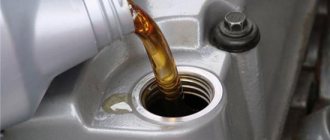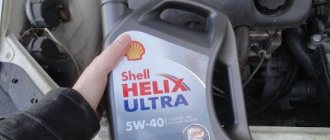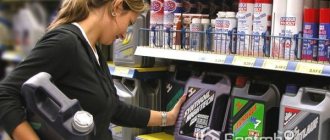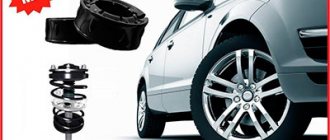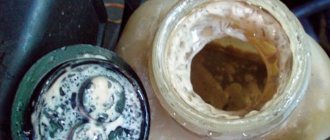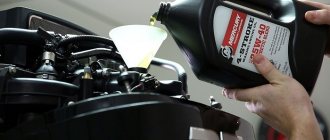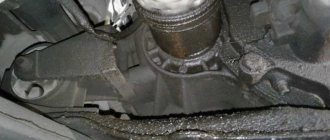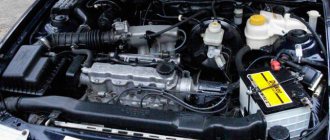One of the common problems with internal combustion engines is oil getting into the cooling system. Such a violation may lead to failure of the power unit and the need for major repairs. Therefore, it is important to be able to timely diagnose a malfunction and eliminate the causes that led to the penetration of lubricant into the antifreeze.
Oil getting into the cooling system is more often observed in foreign car models, but domestic models also suffer from this problem. This defect indicates a lack of tightness in the cooling and lubrication systems. The malfunction must be eliminated immediately, almost at the moment of discovery. Otherwise, the matter will end with a major overhaul of the engine.
The internal combustion engine requires lubricant for efficient operation and cooling. In the head and the cylinder block itself there are special channels - oil and cooling system channels (cooling jacket). The presence of oil in antifreeze can be observed regardless of the characteristics of the engine and the type of fuel used.
Diagnosis of the problem
Evidence that oil has gotten into the antifreeze is most often discovered by chance when checking the refrigerant level in the expansion tank. Visually, this is expressed in a change in the consistency of the antifreeze, color and the presence of oily spots on the neck and walls of the container.
Lubricant and coolant differ in composition and purpose. Mixing them leads to engine fluid leakage.
In addition, there are a number of signs by which one can judge that oil is getting into the antifreeze:
- White smoke may be observed from the exhaust pipe;
- cylinder head gasket leak;
- increased lubricant consumption;
- The refrigerant level will rise sharply.
Additional signs indicating oil in antifreeze: sticky marks inside the oil filter, the appearance of emulsion and foam on the oil filler cap, discoloration on the oil dipstick.
You can independently detect the presence of lubricant in the coolant in the following simple ways:
- when draining the antifreeze, you can detect a change in the color and consistency of the solution in the lower part;
- a piece of paper dipped in antifreeze catches fire. Even weak combustion indicates that oil is present in the antifreeze;
- detection of soot in engine lubricant;
- detection of spherical small clots in the coolant.
Problems with diesel engines
Diesel engines are more susceptible to depressurization. Especially when the car has been idle for a long time. When the engine is constantly cold, the cylinder heads are susceptible to thermal deformation. As a result, the gaskets are displaced, which leads to the merging of liquids.
By the way, diesel cars more often need to change oil and filters.
The key to long-term car service is keeping the engine clean, as well as timely replacement of the car oil along with the coolant.
This must be done according to the schedule provided for a specific machine model. It is also important to do preventative maintenance from time to time.
Reasons for oil getting into the coolant
What is the cause of this malfunction? Most likely it lies in the following:
- malfunction of the cylinder head, including: corrosion of liners;
- gasket wear;
- microcracks on the surface of the cylinder head;
- as well as other damage to parts;
The cause of oil getting into the coolant may be a mismatch in the refrigerants used. For example, a car enthusiast fills in the first antifreeze he comes across, having discovered a low level of the existing one. Various additives in such products contribute to unexpected chemical reactions if the products are incompatible. This reaction is aggressive in nature and leads to the destruction of elements of the cooling system.
The cooling and engine oil supply systems are isolated from each other. The reasons why oil gets into antifreeze are known. Let's try to figure out why some of the malfunctions occur that lead to the appearance of oil in the engine cooling system.
- Pinched cylinder head fasteners or incorrect installation of the head in a service center lead to damage to the integrity of the gasket. Due to the higher pressure in the lubrication system, lubricant enters the cooling system.
- Cracks on the surface of the cylinder head may occur after its repair in cases where it was of poor quality (poor welding quality).
- When oil is found in antifreeze, the cause may lie in the oil cooler. To verify this, dismantling and washing the pipes, and then replacing the refrigerant will help. If, some time after installation and operation, there are no characteristic bubbles on the surface of the cooling product, then the reason is in the cooling system.
In cars with an intercooler (an additional radiator inside the turbine of a diesel engine), possible causes may be as follows:
- oil line damage;
- cracks on the surface of the radiator;
- obstruction or wear of the air duct;
- unsuitability of the oil filter;
- problems with crankcase ventilation, which requires a major overhaul of the power unit.
Many drivers of diesel vehicles often ignore signs indicating oil in the antifreeze, which results in the vehicle being scrapped. By promptly eliminating the cause of oil ingress, you can avoid large financial costs and eventual loss of transport. According to statistics, half of engine failures occur due to oil getting into the antifreeze.
Tips and tricks
As you can see, there is a whole list of possible problems that lead to oil getting into the cooling system and vice versa. It is important to understand that after eliminating the problem, it is imperative to change both the lubricant in the oil system and the coolant in the cooling system.
Moreover, before adding fresh fluids, both systems must be thoroughly flushed. For example, if coolant got into the oil due to the water pump, even after simply replacing the pump, there will be a small amount of liquid in the pan. This means that the existing oil will lose its properties to one degree or another.
Let's imagine a common situation. Let's say the pump was changed, the oil was drained and new oil was added, but without flushing. In this case, up to 10-15% of the old grease mixed with antifreeze will still remain in the pan. So, if you do not flush the oil system first, then the additives in the fresh oil can react with the residues, create deposits and sludge, quickly contaminate the new oil filter, etc.
To prevent this from happening, you can go in two ways:
- remove the tray to remove residues;
- flush the oil system with flushing oil;
We also recommend reading the article about what to do if an emulsion appears on the oil level dipstick and under the oil filler cap. From this article you will learn about the reasons for this malfunction and the available ways to fix the problem.
Although the first option is more difficult, this method is more effective. At the same time, the second method does not require disassembling the internal combustion engine and is simple, as a result of which it becomes the choice of the vast majority of drivers.
Consequences of the problem
If you ignore the signs indicating a malfunction, oil in antifreeze can cause damage to the entire engine.
- Bearing wear occurs due to corrosion. It occurs due to chemical reactions of two incompatible products. As a result, the bearings experience too much load, which leads to their rapid wear.
- A diesel engine jams due to corrosion of the cylinder walls. After stopping the engine and cooling, the coolant enters the combustion chamber and loses its performance properties. This ends with the engine jamming, difficult repairs, and even the loss of the car.
- Due to aggressive reactions, the filter becomes clogged with soot formed as a result of the malfunction. Before replacing the filter itself, it is necessary to eliminate the root cause of the problem.
- Lubricants may stick together due to long-term reaction with the refrigerant. This is due to the presence of ethylene glycol in the coolant, which can corrode parts of the power unit. And its overheating occurs due to the fact that the lubricant increases the viscosity of the antifreeze.
If there is a crack in the cylinder block
This is the most serious outcome of events. In this case, the entire block needs to be replaced. The procedure is quite complicated and expensive. The price is comparable to the cost of a whole engine from disassembly. Whether to install another motor or change the unit on the old one is up to each owner to decide individually. However, this operation is very difficult to perform on your own. The work requires not only experience and knowledge, but also the availability of special tools.
Troubleshooting
Often you have to go to a service station for diagnostics. You can replace the oil cooler gasket yourself if the cause of the malfunction is its wear.
This is done like this:
- cleaning liquid is poured into the refrigerant. The engine starts for a while (up to 10 minutes). This is necessary to warm up the internal combustion engine to operating temperature and start the cooling fans;
- the refrigerant is completely drained through the drain hole under the bottom;
- Using the technical instructions for the car or consulting a specialist, the cooling system is dismantled;
- it is necessary to clean the parts and replace worn gaskets with new ones;
- the coolant expansion tank is removed, thoroughly washed or replaced with a new one;
- Next, you need to rinse the system several times with distilled water (up to 15 liters will be required). To do this, the tank is mounted in its original place and filled with water. The engine and interior airflow start for 10 minutes. After a short interval necessary for cooling, the liquid is drained and the procedure is repeated until the drained fraction becomes completely transparent;
- The drain plug under the bottom of the car is tightened and new antifreeze is poured. It must correspond to the product recommended for use in this vehicle model;
- Next, you will need the help of one more person. It will compress the cooling system pipes when the engine starts and the gas pedal is pressed. The tank lid must be screwed on. This way you get rid of air pockets.
Photo gallery
Photo on cleaning the cooling system of a car.
1. Remove the heat exchanger located next to the BC
2. Clean the device and replace the gasket
3. Remove the container and rinse it thoroughly
4. Clean the cooling system
The first signs of engine oil and coolant leakage
Vehicle owners, while periodically servicing their vehicle, may encounter some problems indicating that the vehicle is leaking fluid. These include:
- presence of dense smoke;
- if the color of the engine fluid or cooling element has changed;
- When checking the cylinder liners, they were found to be bent;
- the volume of coolant has decreased;
- clots are observed on the oil filter;
- There was a rather unpleasant smell in the coolant.
If such signs are found, then you need to find the cause of engine oil getting into the cooling elements.
The consequences of mixing antifreeze and oil
The result of engine contamination with a mixture of two technical fluids will depend on the duration of exposure. First, coking of the bearings occurs, deposition of sticky oil on the internal parts, and corrosion. If you do not pay attention to the signs of malfunction for a long time, then eventually the engine will seize and then only a major overhaul will bring the engine back to life.
When buying a car, be prepared for the fact that you will have to do basic maintenance yourself. Moreover, all recommendations are described in the operating instructions. Having studied the basic knowledge of the machine's structure, you are unlikely to manage to pour coolant into the lubrication system. And knowing how to determine antifreeze in oil, you will not miss an insidious problem.
Video:
Video:
Video:
